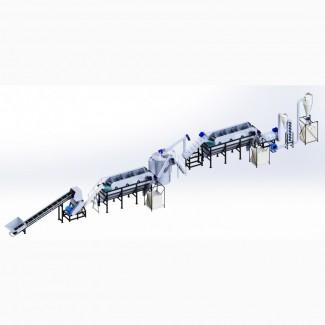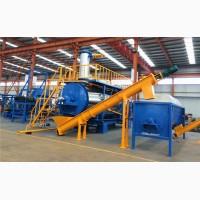Sell / buy
HDPE, HDPE, PVD plastic processing line, Khmelnytskyi region.
Price|| |1342 300 000 UAH.
Region:all of Ukraine,
Khmelnytsk region.
(Khmelnytskyi)
Updated:
Original raw material: HDPE plastic, HDPE, PVD, (|| |151тара from poison chemicals, pesticides, herbicides, fungicides, etc.)
The final product: cleaned flakes with a fraction of 30x30 mm.
Production task: processing of raw materials (cleaning, crushing, washing, washing and drying) with subsequent unloading into Big-Bag, ensuring productivity up to 500 kg/h.
Fig.1 General view of the HDPE, HDPE, PVD plastic processing line
1. Feeding scraper-belt conveyor; 2. Crusher IPR-500; 3. Screw conveyor; 4. Rotary flotation bath 5m3; 5. Hot wash; 6. Friction washer; 7. Washing tub 5m3; 8. Centrifuge; 9. Air transport fan; 10. Mine-type air separator; 11. Cyclone - separator.
The main production stages
Supply of raw materials and crushing: The raw material from the storage area is delivered to the material supply area for the processing technology. Next, the raw material is manually fed into the receiving hopper of the inclined scraper-belt conveyor for loading the IPR-500 crusher. For preliminary washing and cooling of the knives, water is supplied to the working area of the crusher through nozzles. The output fraction of the product and the productivity of the crusher depends on the size of the cells of the lower sieve.
(//tractor-service.com)
Cleaning and washing: After crushing, the material is transferred by a screw conveyor to a rotary flotation bath for washing from mud inclusions. Mud inclusions settle and are removed from the bottom of the bath with an auger. After washing, the raw material enters the lower part of the hot washing tub, where labels, glue and mud residues are removed from it with the help of an alkaline solution at a temperature of up to 90°C. and with intensive mixing, the flakes are washed away. The alkaline solution is heated due to the combustion of organicfuel (firewood) in the lower zone of the sink. At the request of the customer, structural changes can be made to the design of the hot sink: installation of a pellet burner with a controller or a fuel supply hopper (pellets, chips with a technological moisture content of up to 30%). And it can also be supplied with electric curtains for heating the solution, or combined heating (not included in the basic package). The discharge of material from the hot sink is carried out by a screw conveyor from the upper zone. Next, the material enters the friction washer, where the process of washing from the alkaline solution takes place with the help of additional water supply through the zone of the nozzles and removal of the label, adhesive particles remaining on the surface of plastic flakes under the influence of intense friction and centrifugal forces. Next, the material is discharged into a rotary-type washing bath for final washing from the remains of the alkaline solution and removal of all remaining impurities by a screw conveyor from the lower zone of the bath to the centrifuge.
Drying: Flakes from the washing bath enter the centrifuge. Where, under the action of centrifugal forces and intense friction, surface moisture is separated from the flakes. Next, the raw material is fed into a mine-type air separator, where the remnants of the finely dispersed, dusty fraction are selected. At the exit, clean raw materials are discharged with the help of a pneumatic transport fan through a cyclone with a sluice feeder into a Big Bag, which is installed on a separate frame and fastened with the help of quick-release clamps.
Control: The supply of the raw material processing line includes a control cabinet, which ensures the start-up and uniform operation of the entire line by regulating the speed of raw material processing, controlling the temperature of the hot wash solution, and allows you to protect the equipment from damage during operation.
Service staff: 3 people.
Water pressure in the pipeline system: 1.5 - 3.0 atm.
Complete set and materials: drive engines, motor-reducers (СТМ, UMI; WMI Supror; Promoter; Neri Motori; Italy), structural steel low-alloy, stainless AISI 201, 09g2s, 3PS (Ukraine), automation (Nietz, POWTRAN, CHINT, OBEH ).
The equipment is manufactured on the factory premises in Khmelnytskyi, Ukraine, according to a closed production cycle. Technical passports are provided for all individual units and aggregates, as well as general instructions for operating the complex.
The final product: cleaned flakes with a fraction of 30x30 mm.
Production task: processing of raw materials (cleaning, crushing, washing, washing and drying) with subsequent unloading into Big-Bag, ensuring productivity up to 500 kg/h.
Fig.1 General view of the HDPE, HDPE, PVD plastic processing line
1. Feeding scraper-belt conveyor; 2. Crusher IPR-500; 3. Screw conveyor; 4. Rotary flotation bath 5m3; 5. Hot wash; 6. Friction washer; 7. Washing tub 5m3; 8. Centrifuge; 9. Air transport fan; 10. Mine-type air separator; 11. Cyclone - separator.
The main production stages
Supply of raw materials and crushing: The raw material from the storage area is delivered to the material supply area for the processing technology. Next, the raw material is manually fed into the receiving hopper of the inclined scraper-belt conveyor for loading the IPR-500 crusher. For preliminary washing and cooling of the knives, water is supplied to the working area of the crusher through nozzles. The output fraction of the product and the productivity of the crusher depends on the size of the cells of the lower sieve.
(//tractor-service.com)
Cleaning and washing: After crushing, the material is transferred by a screw conveyor to a rotary flotation bath for washing from mud inclusions. Mud inclusions settle and are removed from the bottom of the bath with an auger. After washing, the raw material enters the lower part of the hot washing tub, where labels, glue and mud residues are removed from it with the help of an alkaline solution at a temperature of up to 90°C. and with intensive mixing, the flakes are washed away. The alkaline solution is heated due to the combustion of organicfuel (firewood) in the lower zone of the sink. At the request of the customer, structural changes can be made to the design of the hot sink: installation of a pellet burner with a controller or a fuel supply hopper (pellets, chips with a technological moisture content of up to 30%). And it can also be supplied with electric curtains for heating the solution, or combined heating (not included in the basic package). The discharge of material from the hot sink is carried out by a screw conveyor from the upper zone. Next, the material enters the friction washer, where the process of washing from the alkaline solution takes place with the help of additional water supply through the zone of the nozzles and removal of the label, adhesive particles remaining on the surface of plastic flakes under the influence of intense friction and centrifugal forces. Next, the material is discharged into a rotary-type washing bath for final washing from the remains of the alkaline solution and removal of all remaining impurities by a screw conveyor from the lower zone of the bath to the centrifuge.
Drying: Flakes from the washing bath enter the centrifuge. Where, under the action of centrifugal forces and intense friction, surface moisture is separated from the flakes. Next, the raw material is fed into a mine-type air separator, where the remnants of the finely dispersed, dusty fraction are selected. At the exit, clean raw materials are discharged with the help of a pneumatic transport fan through a cyclone with a sluice feeder into a Big Bag, which is installed on a separate frame and fastened with the help of quick-release clamps.
Control: The supply of the raw material processing line includes a control cabinet, which ensures the start-up and uniform operation of the entire line by regulating the speed of raw material processing, controlling the temperature of the hot wash solution, and allows you to protect the equipment from damage during operation.
Service staff: 3 people.
Water pressure in the pipeline system: 1.5 - 3.0 atm.
Complete set and materials: drive engines, motor-reducers (СТМ, UMI; WMI Supror; Promoter; Neri Motori; Italy), structural steel low-alloy, stainless AISI 201, 09g2s, 3PS (Ukraine), automation (Nietz, POWTRAN, CHINT, OBEH ).
The equipment is manufactured on the factory premises in Khmelnytskyi, Ukraine, according to a closed production cycle. Technical passports are provided for all individual units and aggregates, as well as general instructions for operating the complex.
|
Author, contacts | |
Yuriy Mykolayovych / feedback, info. / activity evaluation | |
|
Phone:
+380xxxxxx|| |205
показати
| |
| youtube.com/watch?v=zoTifUKCYBY&t=14s | |
All user ads ~24 | |
Ad ID: #1110273
(added by a registered user, registration date: 07-05-2016 )
Added / Updated: 03-15-2024 13:35 (current, until: 03-15-2025)
Ad Permanent Address:
Impressions / views for today: ?, total: ?








